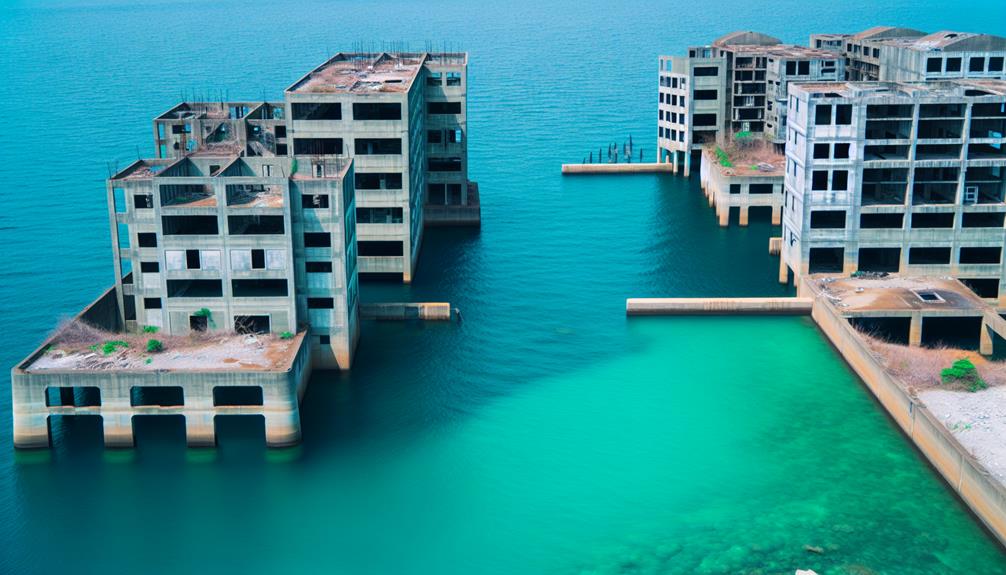Nestled off the Nagasaki coast, Hashima Island stands as a silent witness to a tumultuous past filled with industrial triumphs and subsequent abandonment. Once a bustling coal mining hub, this now-desolate island harbors a wealth of untold stories and mysteries waiting to be unraveled. From its eerie urban exploration opportunities to the lingering whispers of a dark past, Hashima Island beckons curious minds to explore its secrets and contemplate the legacy left behind by its bygone inhabitants.
Key Takeaways
- Known as Gunkanjima, Hashima Island was a coal mining facility.
- Located off the coast of Nagasaki, it experienced economic prosperity in the early 20th century.
- Decline in coal mining due to alternative energy sources impacted population and infrastructure.
- Hashima Island is a reminder of industrial landscapes and technological advancements.
- The island's history includes haunting urban exploration, paranormal stories, and preservation efforts.
The History of Hashima Island
Originally known as Gunkanjima, Hashima Island holds a significant historical background that traces back to its origins as a coal mining facility. The island's mining operations began in 1887 when Mitsubishi purchased the island to extract coal deposits beneath the sea. The strategic location of Hashima Island, off the coast of Nagasaki, made it an ideal site for mining due to the abundance of coal reserves in the area. As mining operations expanded, so did the population on the island, leading to a population boom in the early 20th century.
The rapid increase in population was driven by the demand for labor in the coal mines. Workers and their families flocked to Hashima Island in search of employment opportunities offered by Mitsubishi. The company provided housing and basic amenities for the residents, creating a self-sustaining community on the isolated island. At its peak, Hashima Island was home to over 5,000 residents, making it one of the most densely populated places on earth.
The boom in population and mining activities transformed Hashima Island into a bustling hub of industrial activity. The coal extracted from the mines powered Japan's rapid industrialization during the Meiji period. However, as we will explore in the next subtopic, this industrial boom eventually led to the decline of Hashima Island as coal was gradually replaced by other sources of energy.
Industrial Boom and Decline
The flourishing industrial activities fueled by coal mining on Hashima Island paved the way for its eventual decline as advancements in energy sources began to overshadow the once-thriving coal industry. In the early 20th century, Hashima Island experienced a rapid rise in economic prosperity due to the booming coal mining operations. The island's coal mines were among the most productive in Japan, attracting a large workforce and contributing greatly to the nation's industrial growth.
However, as the world entered a period of industrial transformation and the demand for coal diminished, Hashima Island's economy began to falter. The rise of alternative energy sources such as oil and natural gas led to a decline in the coal industry, ultimately impacting the island's economy. The once-thriving mining community started to dwindle, and businesses that relied on the coal industry suffered.
The economic impact of this shift was profound, leading to a steady decline in population and infrastructure on Hashima Island. As the coal mines became less profitable, companies began to withdraw their operations, further exacerbating the island's economic woes. The rise and fall of the coal industry on Hashima Island serves as a poignant reminder of the ever-changing nature of industrial landscapes and the need for adaptation in the face of technological advancements.
Life on the Abandoned Island
What challenges do individuals face when adapting to life on the now-abandoned Hashima Island?
Life on the desolate Hashima Island poses a myriad of challenges for those who dare to explore its eerie remnants. The abandoned island, once a bustling coal mining town, now stands as a haunting reminder of its industrial past. As individuals venture into this forsaken place, they encounter obstacles that test their resilience and courage. Some of the challenges faced include:
- Decaying Infrastructure: The buildings on Hashima Island have succumbed to years of neglect, with crumbling walls and unstable structures, making navigation hazardous.
- Isolation: The island's remote location and lack of amenities make it a lonely and isolated place, heightening feelings of solitude and vulnerability.
- Environmental Hazards: The harsh coastal climate and exposure to the elements present dangers such as slippery surfaces and potential collapse of weakened structures.
- Supernatural Beliefs: Stories of mysterious disappearances and unexplained phenomena fuel superstitions among visitors, adding an element of fear and uncertainty to their exploration.
Despite these challenges, the allure of exploring ruins and uncovering the mysteries of Hashima Island continues to attract adventurous souls seeking a glimpse into its enigmatic past.
Haunting Urban Exploration Stories
Exploring the abandoned ruins of Hashima Island reveals a tapestry of haunting urban exploration stories that captivate adventurers with their enigmatic allure. The island's desolate structures, once home to thousands of coal miners and their families, now stand as eerie reminders of a bygone era. Brave souls who venture into these decaying buildings often report ghostly encounters and unexplained phenomena, adding to the island's reputation as a hub of paranormal activity.
Forbidden exploration of certain areas on the island only adds to its mystique. The dilapidated apartments, schools, and hospitals whisper tales of the past, sparking the imagination of those who dare to tread its crumbling corridors. Stories of shadowy figures darting out of sight and disembodied voices echoing through the empty halls fuel the chilling atmosphere of Hashima Island.
Urban explorers are drawn to the island not only for its historical significance but also for the thrill of uncovering its secrets. The haunting urban exploration stories that abound on Hashima Island serve as a stark reminder of the impermanence of human endeavors and the enduring legacy of a place left to decay. For those who seek adventure in the unknown, Hashima Island offers a hauntingly unforgettable experience.
Preservation Efforts and Tourism
Efforts to preserve Hashima Island's historical structures and promote tourism have become integral to the island's ongoing narrative of transformation and revitalization. The delicate balance between conservation and development is vital in securing the sustainable future of the island. Key initiatives include:
- Environmental Restoration: Implementing eco-friendly practices such as waste management systems and renewable energy sources to minimize the environmental impact of tourism and preserve the island's natural beauty.
- Sustainable Tourism: Encouraging responsible tourism practices that respect the island's delicate ecosystem and cultural heritage while providing economic benefits to the local community.
- Cultural Heritage: Protecting and showcasing the unique historical structures on the island, such as the abandoned apartment blocks and industrial facilities, to educate visitors about Hashima's rich heritage.
- Community Engagement: Involving local residents in decision-making processes and tourism initiatives to ensure that the benefits of tourism are distributed equitably and that the community's voice is heard.
These efforts not only aim to attract visitors to experience the island's haunting beauty but also to preserve its historical significance for future generations. By striking a balance between conservation and development, Hashima Island can continue to evolve as a symbol of resilience and transformation while safeguarding its cultural and environmental legacy.
Uncovering Hashima's Dark Secrets
The allure of Hashima Island's historical structures and tourism potential has sparked growing interest in unearthing the hidden truths and enigmatic past that lie beneath its facade. As visitors explore the decaying buildings and abandoned homes, some have reported eerie ghostly encounters, adding fuel to the conspiracy theories that shroud the island in mystery.
One of the most prevalent conspiracy theories surrounding Hashima Island is the alleged cover-up of dark historical events that took place during its industrial peak. Stories of forced labor, inhumane working conditions, and unmarked graves have circulated among historians and visitors alike, raising questions about the true nature of the island's past.
Moreover, the desolate atmosphere of Hashima Island has fueled speculation about government experiments and clandestine operations conducted on the island. Whispers of secret underground facilities and hidden chambers have led some to believe that there is more to Hashima's history than meets the eye.
Despite efforts to preserve Hashima's structures and promote tourism, the island's dark secrets continue to captivate the imagination of those who dare to explore its haunting corridors. Whether fueled by ghostly encounters or conspiracy theories, the allure of Hashima's enigmatic past remains a potent force in attracting visitors seeking to uncover the mysteries that lie buried within its walls.
Frequently Asked Questions
Are There Any Hidden Tunnels or Secret Passages on Hashima Island?
In exploring the existence of hidden tunnels or secret passages on islands, the allure of uncovering an underground network adds a layer of mystery and historical significance. Such features, if present, could reveal insights into past activities and provide a glimpse into the island's historical context.
The presence of hidden pathways often sparks curiosity and intrigue, shedding light on the island's covert operations or strategic significance.
What Kind of Wildlife Can Be Found on the Abandoned Island?
The abandoned island supports a diverse array of marine life, contributing to its unique ecosystem. Exploration of the island reveals a delicate balance between preservation and the natural order of wildlife.
The presence of various species underscores the importance of understanding and appreciating the interdependence of these organisms within their environment.
This harmonious coexistence serves as a proof to the resilience and adaptability of the island's wildlife in the face of isolation and abandonment.
Are There Any Plans to Develop Hashima Island in the Future?
In considering future development and preservation efforts for a location, various factors must be taken into account. These may include:
- Environmental impact assessments
- Community engagement
- Economic feasibility studies
- Adherence to heritage preservation guidelines
Balancing the need for progress with the importance of safeguarding cultural and natural heritage is vital in shaping the future trajectory of a site. It is essential to carefully weigh these considerations to promote sustainable and responsible development.
How Do Visitors Access the Island for Urban Exploration Tours?
When planning urban exploration tours, visitors typically access remote islands like Hashima through a variety of transportation options, such as boats or ferries. Safety precautions must be considered, including following guidelines set forth by tour operators, wearing appropriate gear, and being aware of potential hazards.
In ensuring a safe and enjoyable experience, visitors should adhere to all rules and regulations while exploring these unique and sometimes challenging locations.
Are There Any Reported Paranormal Activities on Hashima Island?
Reports of ghost sightings and supernatural occurrences often pique curiosity, sparking interest in local folklore and mysterious legends. These stories can add an intriguing layer to historical sites, drawing in visitors seeking a thrill or a deeper connection to the past.
Paranormal activities can range from unexplained phenomena to eerie encounters, contributing to the mystique and allure of certain locations. Such tales can captivate imaginations and inspire exploration beyond the tangible world.
Conclusion
To sum up, Hashima Island, once a bustling coal mining facility, now stands as a haunting reminder of industrial decline. With over 5,000 residents at its peak, the island now lies abandoned, attracting urban explorers and tourists intrigued by its mysterious past.
As of 2021, efforts to preserve Hashima's historical significance have led to an increase in tourism, with over 100,000 visitors annually exploring its decaying infrastructure and uncovering its dark secrets.


